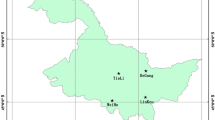Abstract
Genetic variation in seed/cone production among clones was studied in a hinoki (Chamaecyparis obtusa Endl.) seed orchard containing 25 plus-trees by analyzing the number of cones, the yield of cones and seeds of individual ramets for 5 successive years (1982 to 1986). There was significant variation among clones each year and parental contribution in the seed orchard. Specifically, in the years 1982, 1983, 1984, 1985, and 1986, 20% of the clones produced 37.2, 60.6, 36.0, 44.3, and 44.8% of the total cones, respectively. The size of the crop greatly influenced the parental balance in the resulting seed/cone crops. The product moment correlation coefficients and Spearman’s coefficients of rank correlation were small and insignificant between consecutive years, but large and highly significant between alternate years, suggesting the presence of carry-over effects in seed/cone production. The broad-sense heritability on a clone mean basis was 0.74 ± 0.15 for the number of cones, 0.72 ± 0.14 for the yield of cones, and 0.68 ± 0.13 for the yield of seeds. The corresponding heritabilities from analyses combined over all years were 0.24, 0.558, and 0.724, respectively. These results indicate that seed/cone production in hinoki is under strong genetic control. Several managerial measures are discussed that maintain the genetic diversity in seedlots used for reforestation, by reducing the variation in seed/cone production among clones and producing seed crops with equal contributions from all parents.
Similar content being viewed by others

Literature cited
Byram, T.D., Lowe, W.J., and McGriff, J.A. (1986) Clonal and annual variation in cone production in loblolly pine seed orchards. Forest Sci. 32: 1067–1073.
Chaisurisri, K., Edwards, D.G.W., and El-Kassaby, Y.A. (1992) Genetic control of seed size and germination in Sitka spruce. Silvae Genet. 41: 348–355.
Danieis, J.D. (1978) Efficiency of supplemental mass pollination in Douglas-fir seed orchard. Silvae Genet. 27: 52–58.
El-Kassaby, Y.A. and Ritland, K. (1986) The relation of outcross and contamination to productive phenology and supplemental mass pollination in a Douglas-fir seed orchard. Silvae Genet. 35: 240–244.
El-Kassaby, Y.A., Fashler, A.M. K., and Crown, M. (1989) Variation in fruitfulness in a Douglas-fir seed orchard and its effect on crop-management decisions. Silvae Genet. 38: 113–121.
Eriksson, G., Jonsson, A., and Lindgren, D. (1973) Flowering in a clone trail ofPicea abies Karst. Stud. For. Suec. 110: 1–45.
Griffin, A.R. (1982) Clonal variations in radiata pine seed orchard. I. Some flowering, cone and seed production traits. Aust. J. For. Res. 12: 295–302.
Ide, Y. and Yamamoto, S. (1989) Establishment of techniques for promoting strobile production in a hinoki (Chamaecyparis obtusa) seed orchard: Effective method of gibberellin treatment. Bull. Shizuoka Pref. For. Tech. Center 17: 1–28. (in Japanese)
International Seed Testing Association (1985) International rules for seed testing. Seed Sci. Technol. 13: 299–513.
Katsuta, M. (1982) Production ability of hinoki seed orchard in Sakasita and its effect on crop management decisions. For. Breed. 124: 13–19. (in Japanese)
Matziris, D. (1993) Variation in cone production in a clonal seed orchard of black pine. Silvae Genet. 42: 136–141.
Matziris, D. (1997) Variation in growth, flowering and cone production in a clonal seed orchard of Aleppo pine grown in Greece. Silvae Genet. 46: 224–228.
Miller, G.E. (1982) Phytotoxicity of Douglas-fir megastrobili and efficacy against Douglas-fir cone gall midge of five fatty acid derivatives. Can. J. For. Res. 12: 1021–1024.
Miller, G.E. (1983) Evaluation of the effectiveness of cool-water misting of trees in a seed orchard for control of Douglas-fir gall midge (Diptera: Cecidomyiidea). J. Econ. Entomol. 76: 916–919.
Sano, N., Torii, H., Ide, Y., and Takahashi, A. (1989) Damage caused by cone pests in a hinoki seed orchard (Chamaecyparis obtusa). Proc. 37th Mtg. of Chubu Branch, Jpn. For. Soc. 37: 235–236. (in Japanese)
Seido, K. (1990) Isozyme variation and estimated self-fertilization rate in aChamaecyparis obtusa seed orchard. Trans. Jpn. For. Soc. 101: 301–302. (in Japanese)
Author information
Authors and Affiliations
About this article
Cite this article
Tang, DQ., Ide, Y. Genetic variation in fruitfulness in a hinoki (Chamaecyparis obtusa Endl.) seed orchard and its impact on the maintenance of genetic diversity in seedlots. J For Res 6, 67–72 (2001). https://doi.org/10.1007/BF02762490
Accepted:
Issue Date:
DOI: https://doi.org/10.1007/BF02762490



